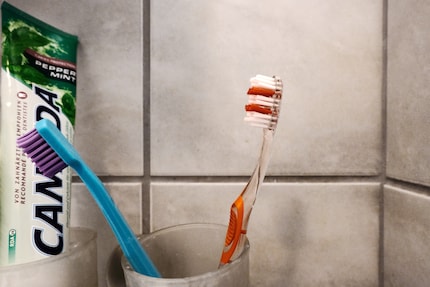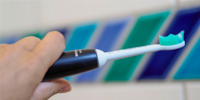

Why do toothbrushes have coloured bristles?
Many toothbrushes don’t just have white bristles, but coloured ones. Ever asked yourself why? Read on to find out. Spoiler: it’s not only a design choice.
Toothbrushes come in all kinds of colours. As a child with four siblings, this was handy because I always knew which one was mine. I’d go for green or blue, my sister chose red and my brothers didn’t care. Not only the handles can be coloured, but also the bristles.
Why’s that?
I’d never thought about this until I came across a TikTok video via an online article (in German) in which a teacher answers the question. The coloured bristles let you know how much toothpaste to use.
Higi Berchtold, Head of Sales and Marketing at the Swiss toothbrush brand Curaprox, confirms this. «Some manufacturers do this – they most often colour the tips and the middle part of the bristles.» Curaprox launched a special edition by a female artist some time ago, featuring a coloured toothpaste dosage circle.

Source: Carolin Teufelberger
«Apart from the one special edition, our toothbrushes don’t have coloured bristles to indicate how much toothpaste is needed. After all, it’s an individual matter.» She goes on to explain that a small child needs only a grain-of-rice-sized amount of toothpaste, while adults are recommended to use a pea-sized amount. In any case, the sausage I like to pull over the entire length of the bristles is too much.
According to Higi Berchtold, your mouth doesn’t need to be filled with foam while you’re brushing your teeth, either. What produces the foam is sodium lauryl sulfate (SLS) – a controversial substance that can trigger allergies and canker sores. However, I’m going to ignore that, as I don’t enjoy brushing my teeth without foam. It just doesn’t feel right. That’s also the reason why I stopped using sustainable toothpaste.
Why does the second hand of the Swiss railway clock pause before a new minute? Why is popcorn served at the movies? And why don’t beverage glasses go in the same bin as other glass? Everyday life is filled with intriguing questions, the answers to which I’m determined to find. If you have a burning question of your own but no time to research it, shoot me an e-mail. I like doing the dirty work.
My life in a nutshell? On a quest to broaden my horizon. I love discovering and learning new skills and I see a chance to experience something new in everything – be it travelling, reading, cooking, movies or DIY.
Interesting facts about products, behind-the-scenes looks at manufacturers and deep-dives on interesting people.
Show all



